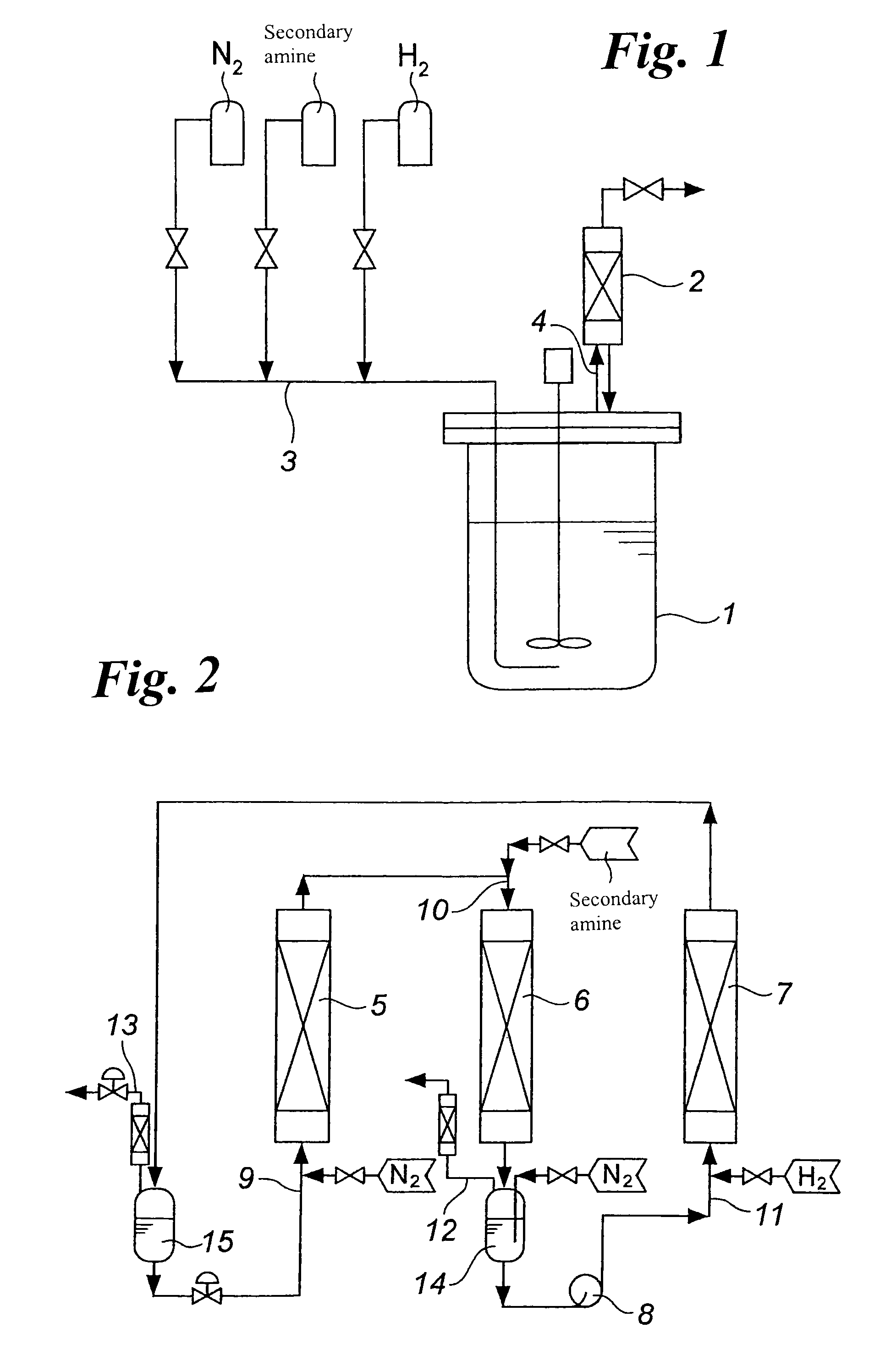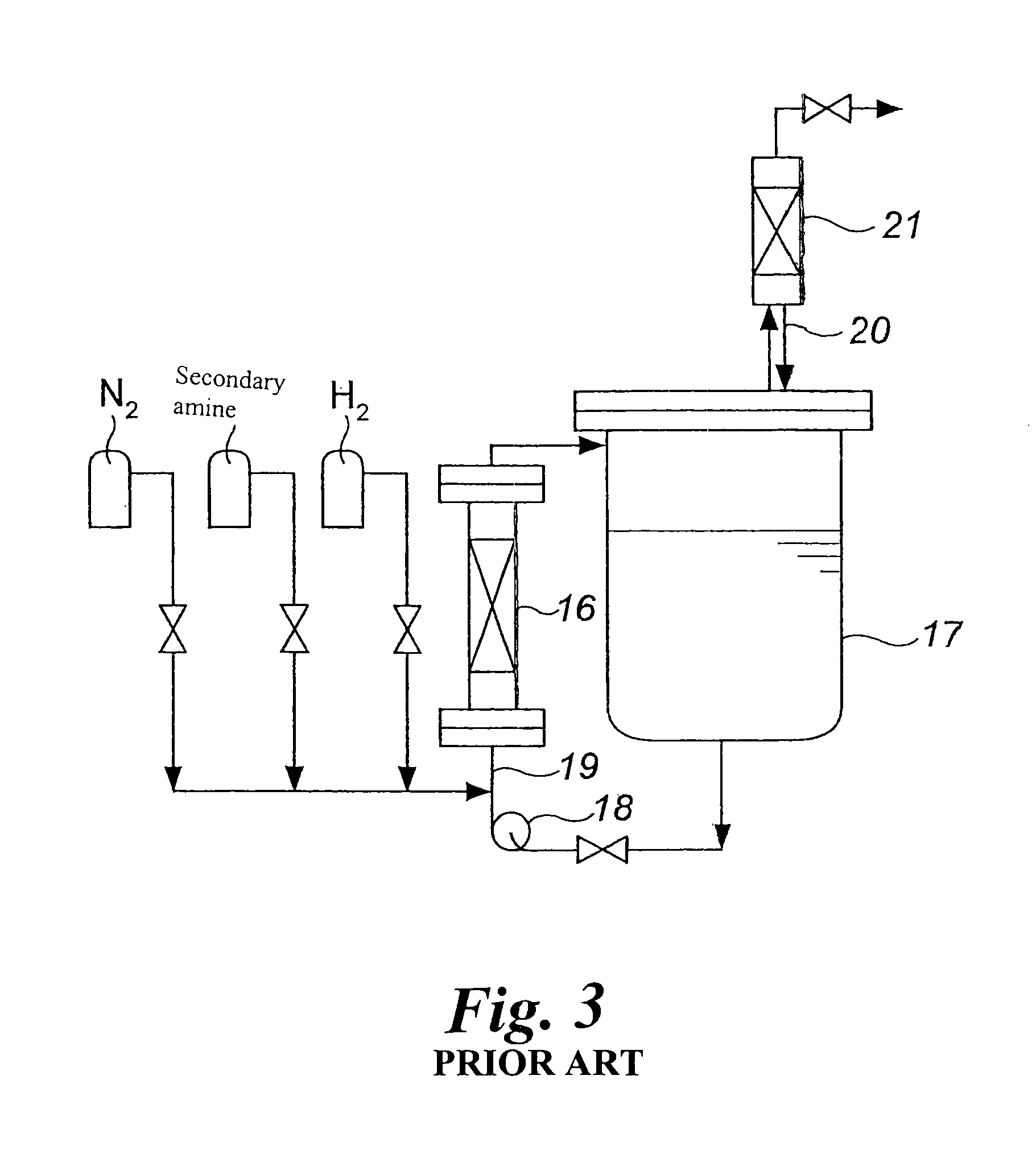Process for producing tertiary amine
a technology of tertiary amine and amine, which is applied in the field of process for producing tertiary amine, can solve the problems of considerable undesired side products, hardly obtained corresponding tertiary amine highly selectively,
- Summary
- Abstract
- Description
- Claims
- Application Information
AI Technical Summary
Benefits of technology
Problems solved by technology
Method used
Image
Examples
production example 1
Production of a Powdery Catalyst
[0078]Synthetic zeolite was charged into a 1-L flask, and then a solution of copper nitrate, nickel nitrate and ruthenium chloride dissolved in water in a molar ratio of Cu:Ni:Ru=4:1:0.01, and then the solution was heated under stirring. An aqueous solution of 10 wt % Na2CO3 was added dropwise thereto at 90° C. while the pH of the aqueous solution was controlled in the range of 9 to 10. After aging for 1 hour, the precipitates were filtered, washed with water, dried at 80° C. for 10 hours and calcined at 600° C. for 3 hours to obtain a powdery catalyst.
[0079]In the resulting powdery catalyst, the proportion of the metal oxide was 50%, and the proportion of the synthetic zeolite was 50%.
production example 2
Production of a Pellet-Type Catalyst
[0080]The powder before calcination obtained in the step of preparing the powdery catalyst in Production Example 1 was molded into tablets in a cylindrical form of 3 mmφ×3 mm and then calcinated at 600° C. for 3 hours to obtain a ternary pellet-type catalyst having copper-nickel-ruthenium supported on synthetic zeolite.
[0081]In the resulting pellet-type catalyst, the proportion of the metal oxide was 50%, and the proportion of the synthetic zeolite was 50%.
production example 3
Production of a Film-Type Catalyst
[0082]Phenol resin (PR-9480 with 58% non-volatiles, manufactured by Sumitomo Bakelite) was added as a binder to 100 parts of the powdery catalyst in Production Example 1 such that the content of non-volatiles in the phenol resin became 47.7 parts. 2-Butanone was added as solvent thereto such that solids content (the powdery catalyst and non-volatiles in the phenol resin) became 55%. The mixture was preliminarily mixed by a Disper for 10 minutes, then mixed and dispersed at 1500 rpm for 70 minutes in a basket mill (SS-3, charged with 1900 g (800 mL) titania beads having a diameter of 1.4 mm, manufactured by ASADA IRON WORKS, Co., Ltd.) to form a coating. A copper foil (thickness 40 μm) was used as a support, and the coating was applied by a bar coater on both sides of the support and dried at 150° C. for 30 seconds. Half of the resulting dried specimen was corrugated in a corrugate form, stacked alternately with the remaining planar catalyst specimen...
PUM
| Property | Measurement | Unit |
|---|---|---|
| temperature | aaaaa | aaaaa |
| temperature | aaaaa | aaaaa |
| temperature | aaaaa | aaaaa |
Abstract
Description
Claims
Application Information
 Login to View More
Login to View More - R&D
- Intellectual Property
- Life Sciences
- Materials
- Tech Scout
- Unparalleled Data Quality
- Higher Quality Content
- 60% Fewer Hallucinations
Browse by: Latest US Patents, China's latest patents, Technical Efficacy Thesaurus, Application Domain, Technology Topic, Popular Technical Reports.
© 2025 PatSnap. All rights reserved.Legal|Privacy policy|Modern Slavery Act Transparency Statement|Sitemap|About US| Contact US: help@patsnap.com


